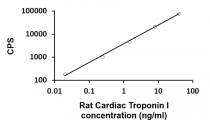ARG10144
anti-Cardiac Troponin I antibody [4C2]
anti-Cardiac Troponin I antibody [4C2] for ELISA,IHC-Formalin-fixed paraffin-embedded sections,Western blot and Human,Mouse,Rat,Bovine,Dog,Pig
Cell Biology and Cellular Response antibody; Controls and Markers antibody; Developmental Biology antibody; Signaling Transduction antibody
Overview
| Product Description | Mouse Monoclonal antibody [4C2] recognizes Cardiac Troponin I |
|---|---|
| Tested Reactivity | Hu, Ms, Rat, Bov, Dog, Pig |
| Tested Application | ELISA, IHC-P, WB |
| Host | Mouse |
| Clonality | Monoclonal |
| Clone | 4C2 |
| Isotype | IgG2a |
| Target Name | Cardiac Troponin I |
| Antigen Species | Human |
| Immunogen | free human cTnI, native human cTn complex, or human cTnI peptides. |
| Epitope | a.a. 23-29 (SSNYRAYA) |
| Conjugation | Un-conjugated |
| Alternate Names | RCM1; cTnI; Cardiac troponin I; TNNC1; CMD1FF; CMD2A; Troponin I, cardiac muscle; CMH7 |
Application Instructions
| Application Suggestion |
|
||||||||
|---|---|---|---|---|---|---|---|---|---|
| Application Note | ELISA: This antibody (in biotinylated form) can be used as capture antibody in sandwich ELISA in combination with Eu-labeled ARG10125 anti-Cardiac Troponin I antibody [19C7] as detection antibody. IHC-P: Antigen Retrieval: Heat mediated was performed using Tris/EDTA buffer pH 9.0 or citrate buffer pH 6.0. * The dilutions indicate recommended starting dilutions and the optimal dilutions or concentrations should be determined by the scientist. |
Properties
| Form | Liquid |
|---|---|
| Purification | Protein A affinity purified. |
| Buffer | PBS (pH 7.4) and 0.1% Sodium azide |
| Preservative | 0.1% Sodium azide |
| Concentration | 1.0-2.0 mg/ml |
| Storage Instruction | For continuous use, store undiluted antibody at 2-8°C for up to a week. For long-term storage, aliquot and store at -20°C or below. Storage in frost free freezers is not recommended. Avoid repeated freeze/thaw cycles. Suggest spin the vial prior to opening. The antibody solution should be gently mixed before use. |
| Note | For laboratory research only, not for drug, diagnostic or other use. |
Bioinformation
| Database Links | |
|---|---|
| Gene Symbol | TNNI3 |
| Gene Full Name | troponin I type 3 (cardiac) |
| Background | Troponin I (TnI), along with troponin T (TnT) and troponin C (TnC), is one of 3 subunits that form the troponin complex of the thin filaments of striated muscle. TnI is the inhibitory subunit; blocking actin-myosin interactions and thereby mediating striated muscle relaxation. The TnI subfamily contains three genes: TnI-skeletal-fast-twitch, TnI-skeletal-slow-twitch, and TnI-cardiac. This gene encodes the TnI-cardiac protein and is exclusively expressed in cardiac muscle tissues. Mutations in this gene cause familial hypertrophic cardiomyopathy type 7 (CMH7) and familial restrictive cardiomyopathy (RCM). [provided by RefSeq, Jul 2008] |
| Function | Troponin I is the inhibitory subunit of troponin, the thin filament regulatory complex which confers calcium-sensitivity to striated muscle actomyosin ATPase activity. [UniProt] |
| Research Area | Cell Biology and Cellular Response antibody; Controls and Markers antibody; Developmental Biology antibody; Signaling Transduction antibody |
| Calculated MW | 24 kDa |
| PTM | Phosphorylated at Ser-42 and Ser-44 by PRKCE; phosphorylation increases myocardium contractile dysfunction (By similarity). Phosphorylated at Ser-23 and Ser-24 by PRKD1; phosphorylation reduces myofilament calcium sensitivity. Phosphorylated preferentially at Thr-31. Phosphorylation by STK4/MST1 alters its binding affinity to TNNC1 (cardiac Tn-C) and TNNT2 (cardiac Tn-T). |
Images (1) Click the Picture to Zoom In
-
ARG10144 anti-Cardiac Troponin I antibody [4C2] ELISA image
Sandwich ELISA: Calibration curve for purified Rat Cardiac Troponin I. ARG10144 anti-Cardiac Troponin I antibody [4C2] (in biotinylated form) can be used as capture antibody in sandwich ELISA in combination with Eu-labeled ARG10125 anti-Cardiac Troponin I antibody [19C7] as detection antibody.
Loading: 200 ng/well of capture and detection antibodies.








